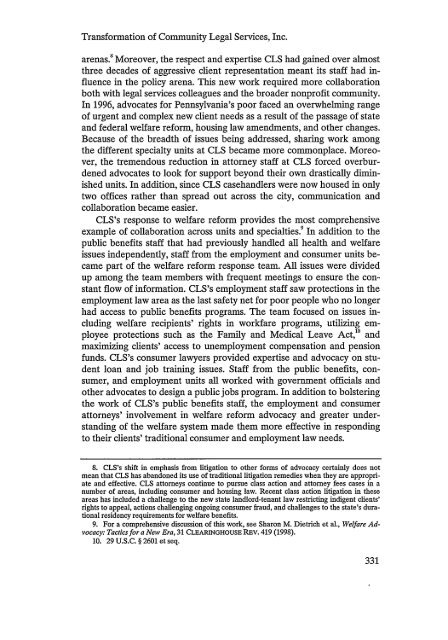Law for The Poor
Law for The Poor
Law for The Poor
You also want an ePaper? Increase the reach of your titles
YUMPU automatically turns print PDFs into web optimized ePapers that Google loves.
Trans<strong>for</strong>mation of Community Legal Services, Inc.<br />
arenas." Moreover, the respect and expertise CLS had gained over almost<br />
three decades of aggressive client representation meant its staff had influence<br />
in the policy arena. This new work required more collaboration<br />
both with legal services colleagues and the broader nonprofit community.<br />
In 1996, advocates <strong>for</strong> Pennsylvania's poor faced an overwhelming range<br />
of urgent and complex new client needs as a result of the passage of state<br />
and federal welfare re<strong>for</strong>m, housing law amendments, and other changes.<br />
Because of the breadth of issues being addressed, sharing work among<br />
the different specialty units at CLS became more commonplace. Moreover,<br />
the tremendous reduction in attorney staff at CLS <strong>for</strong>ced overburdened<br />
advocates to look <strong>for</strong> support beyond their own drastically diminished<br />
units. In addition, since CLS casehandlers were now housed in only<br />
two offices rather than spread out across the city, communication and<br />
collaboration became easier.<br />
CLS's response to welfare re<strong>for</strong>m provides the most comprehensive<br />
example of collaboration across units and specialties.! In addition to the<br />
public benefits staff that had previously handled all health and welfare<br />
issues independently, staff from the employment and consumer units became<br />
part of the welfare re<strong>for</strong>m response team. All issues were divided<br />
up among the team members with frequent meetings to ensure the constant<br />
flow of in<strong>for</strong>mation. CLS's employment staff saw protections in the<br />
employment law area as the last safety net <strong>for</strong> poor people who no longer<br />
had access to public benefits programs. <strong>The</strong> team focused on issues including<br />
welfare recipients' rights in workfare programs, utilizing employee<br />
protections such as the Family and Medical Leave Act, 10 and<br />
maximizing clients' access to unemployment compensation and pension<br />
funds. CLS's consumer lawyers provided expertise and advocacy on student<br />
loan and job training issues. Staff from the public benefits, consumer,<br />
and employment units all worked with government officials and<br />
other advocates to design a public jobs program. In addition to bolstering<br />
the work of CLS's public benefits staff, the employment and consumer<br />
attorneys' involvement in welfare re<strong>for</strong>m advocacy and greater understanding<br />
of the welfare system made them more effective in responding<br />
to their clients' traditional consumer and employment law needs.<br />
8. CLS's shift in emphasis from litigation to other <strong>for</strong>ms of advocacy certainly does not<br />
mean that CLS has abandoned its use of traditional litigation remedies when they are appropriate<br />
and effective. CLS attorneys continue to pursue class action and attorney fees cases in a<br />
number of areas, including consumer and housing law. Recent class action litigation in these<br />
areas has included a challenge to the new state landlord-tenant law restricting indigent clients'<br />
rights to appeal, actions challenging ongoing consumer fraud, and challenges to the state's durational<br />
residency requirements <strong>for</strong> welfare benefits.<br />
9. For a comprehensive discussion of this work, see Sharon M. Dietrich et al., Welfare Advocacy:<br />
Tactics <strong>for</strong> a New Era, 31 CLEARINGHOUSE REV. 419 (1998).<br />
10. 29 U.S.C. § 2601 et seq.

















